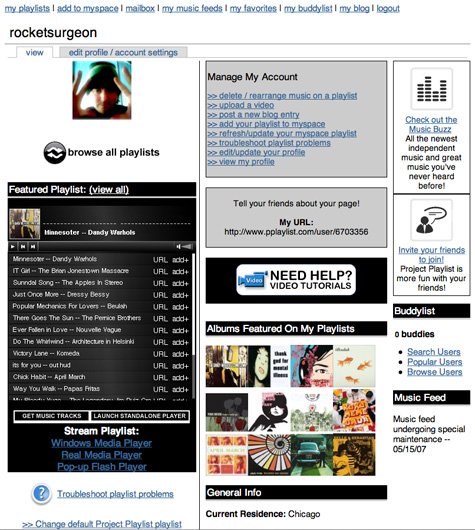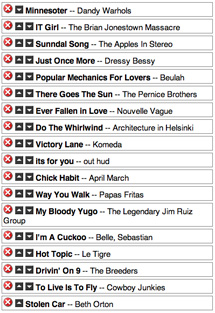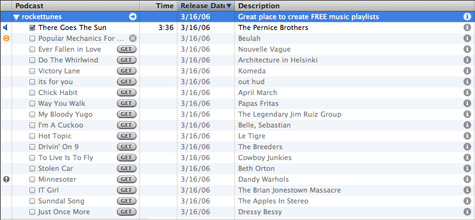 Project Playlist is a perfect example of how access to free music, combined with MySpace distribution often trumps good user experience and design. Based on some analysis using Compete statistics, blogger David Porter shows a massive expansion of PP’s user base since the beginning of the year. Further analysis using Comscore shows similar growth. PP is a free service and music search engine that allows users to find mp3 files from around the web an add them to their own playlists. Once a playlist has been created, you can embed it into any web page or blog to share it with the world. PP’s about page states that:
Project Playlist is a perfect example of how access to free music, combined with MySpace distribution often trumps good user experience and design. Based on some analysis using Compete statistics, blogger David Porter shows a massive expansion of PP’s user base since the beginning of the year. Further analysis using Comscore shows similar growth. PP is a free service and music search engine that allows users to find mp3 files from around the web an add them to their own playlists. Once a playlist has been created, you can embed it into any web page or blog to share it with the world. PP’s about page states that:
“More and more, music is being released on the web for promotional purposes (through mp3 music blogs, artist websites, label websites and other sources), or for free distribution by the artist or label in order to drive concert and merchandise sales.”
Well that is true and makes them sound like they are on solid legal ground but PP’s search engine does not limit itself to just legal files and predominantly returns search results of mostly illegal files.
Registration & Profile
Like most Music 2.0 sites, PP has a fairly straightforward registration process. After completing registration, you can configure your profile page which includes the standard fare such as My Playlists, General Info, My Blogs, Buddies, Music Interests, etc. The overall design and layout of the page, like most of the site, is a complete mess. Aside from poorly organized information blocks, the mostly monochromatic UI mixes a variety of navigation styles (links, tabs, buttons, etc.) which drastically impairs the site’s usability. Additionally there is no way to customize the layout and colors of your profile page.

Finding Music
Instead of taking up half the site header area with branding, PP should introduce a persistent search box. The current implementation requires you to click the “search for music” tab every time you want to perform the key task of the site. The search engine allows you to search for artists and songs across the web (blog and concert search is coming soon).
The engine returns a paltry 10 results per page (gotta get those page views up for advertisers like the aircraft broker who showed up on a search for Beulah) which seem to be sorted by relevance. It would be great if there was a way to get an alphabetic sort here as well since finding a single song from a popular artist can be challenging. Each result has an associated Play and Add button. When you click the play button the song automatically begins playing inline. Why the page displays another play/stop button instead of using the one you originally clicked escapes me. If you click another play button on the page, the first song continues to play as the second one begins - a great feature if you do a search for Row Your Boat but otherwise really annoying.
Browsing user playlists is a pretty futile task with PP. Basically PP provides just a single, paginated list of user playlists. There is no way to search playlists or browse them by theme, genre, etc. Additionally there is no way to browse other users in any way other then stumbling upon them.
 Creating & Managing Playlists
Creating & Managing Playlists
Once you have found a song you like in your search results, you can click the “+” button to add it to a playlist. Instead of using DHTML or AJAX widgets to do this, PP takes you to a page that asks you to test to see if the song plays. Once you confirm, it takes you to another page where you select which playlist (if you have more than one) the song should be added to. You are then taken to a confirmation page which has a link back to the original search results page. Managing your playlist order is fairly straightforward. You can use in-page drag-and-drop editing or use up and down arrows. From what I can tell, there is no ability to set a playlist as private. PP also doesn’t provide good tools for when a song in your playlist is deleted from the Internet (since site owners are have to pay for their bandwidth usage, songs on popular playlists will likely be removed due to the traffic burden). Instead of automatically removing the song from your list, it will stay there and simply not play - you need to manually replace the song with a valid copy.
Sharing Playlists
PP provides multiple methods to access and share your playlists. You can play your list in in Windows Media Player, Real Player and a Flash player. More interesting is the ability to subscribe to your list as an iTunes podcast which then allows you to put the playlists and individual tracks on your iPod or hard drive. PP also provides simple methods to generate code for an embedded player on MySpace, Facebook or other blogs and web pages. You can partially customize the player’s colors and set the playlist for autostart (please don’t) and random shuffle. You can adjust the width of the player by tweaking the code.

Conclusion
There are many other playlist creation services out there such as Finetune, iMeem, and Fiql that have done a great job at balancing a great user experience with solid content. These services either require you to use an existing catalog, use files within the network, or upload your own files. PP’s approach of creating playlists based on links to songs on the Internet is a worthwhile concept though legally murky and prone to a host of content management and metadata issues. Perhaps it is this simplicity of this approach that is helping PP gain so much traction. Now if they can just invest some of the money from the massive amount of ads on the site into richer features and a better user experience they could really be onto something.
Here is a playlist i created in Project Playlist:


